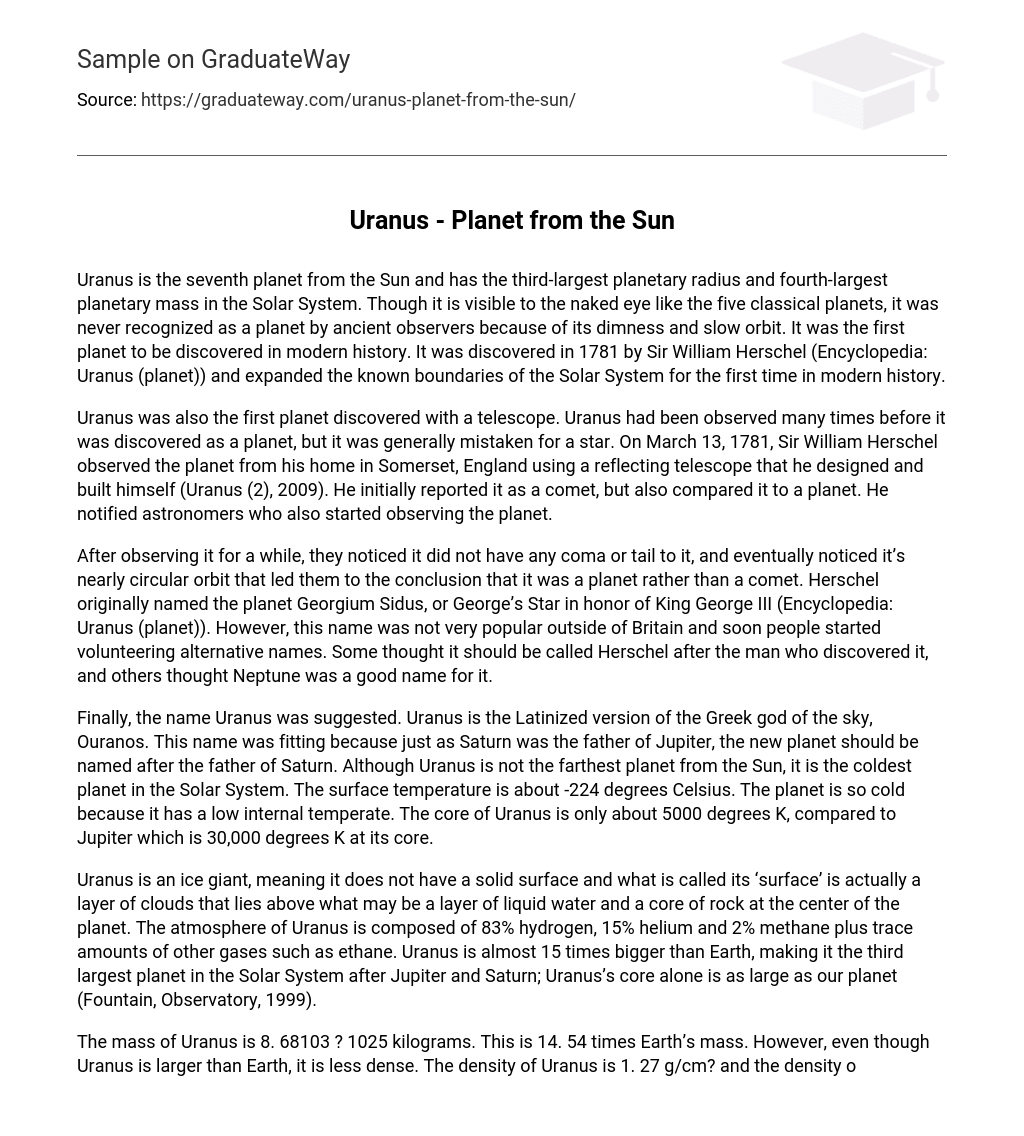Uranus, the seventh planet from the Sun, has the third-largest planetary radius and fourth-largest planetary mass in the Solar System. Despite being visible to the naked eye like the five classical planets, its dimness and slow orbit prevented ancient observers from recognizing it as a planet. However, it was eventually discovered in 1781 by Sir William Herschel, marking the first planet to be discovered in modern history. This discovery expanded the known boundaries of the Solar System for the first time in modern history (Encyclopedia: Uranus (planet)).
Uranus, the first planet discovered with a telescope, had previously been observed numerous times but was often mistaken for a star. On March 13, 1781, Sir William Herschel observed Uranus through his own reflecting telescope at his residence in Somerset, England. He initially identified it as a comet, but also acknowledged its resemblance to a planet. Following this discovery, Herschel alerted other astronomers who began observing Uranus as well (Uranus (2), 2009).
Upon observation, it was discovered that the object had no coma or tail. Its nearly circular orbit led scientists to conclude that it was a planet, not a comet. Initially, Herschel named the planet Georgium Sidus, which means George’s Star in honor of King George III. However, this name was not widely accepted outside of Britain, and alternative names were suggested. Some proposed naming it Herschel after its discoverer, while others favored the name Neptune.
Uranus, named after the Latinized version of the Greek god Ouranos, is our Solar System’s coldest planet with a surface temperature of around -224 degrees Celsius. Despite not being the farthest from the Sun, its frigid temperatures are due to its low internal temperature. This is evident in Uranus’ core temperature of 5000 degrees K, significantly lower than Jupiter’s core temperature of 30,000 degrees K.
Uranus, an ice giant, lacks a solid surface and instead has a layer of clouds known as its ‘surface’, situated above a potential layer of liquid water and rock core at the planet’s center. The composition of Uranus’ atmosphere consists of 83% hydrogen, 15% helium, and 2% methane, alongside trace amounts of other gases like ethane. In terms of size, Uranus is approximately 15 times larger than Earth, making it the third largest planet in our Solar System after Jupiter and Saturn. It is worth noting that the size of Uranus’ core alone matches that of our entire planet (Fountain, Observatory, 1999).
Uranus, with a mass of 8.68103 × 10^25 kilograms, is 14.54 times the mass of Earth. Despite its larger size, Uranus has a lower density compared to Earth, with Uranus having a density of 1.27 g/cm³ and Earth having a density of 5.52 g/cm³ (Encyclopedia: Uranus (planet)).
The average distance between Uranus and the Sun is approximately 3 billion km or 20 astronomical units (AU). It takes about 84 Earth years for Uranus to complete one revolution around the Sun, while it completes one full rotation in about17 hours and14 minutes (Uranus (2),2009).
Uranus has an axis tilt of98 degrees with respect to its orbital plane. This tilt causes alternating periods of lightness and darkness that last for approximately half of its orbit, which amounts to about42 years at each end because during half of its orbit one pole points almost directly towards the Sun while the other pole points towards the Sun during the second half (Encyclopedia: Uranus(planet)).
According to Fountain (2007), Uranus has 10 known rings and a minimum of 18 moons, although recent studies indicate there could be as many as 27. Due to its gaseous surface composition, volcanic activity is absent on Uranus. Nevertheless, certain moons of Uranus may possess ice-spewing volcanoes (Fountain, 1999). Contrary to previous belief in its monotonous climate, the Hubble Space Telescope has unveiled dynamic weather patterns on the planet (Colombo, 1998).
Despite receiving less energy from the Sun compared to Earth, Uranus still encounters intense wind storms, with wind speeds reaching up to 900 km/hr. One of these storms, known as the Great Dark Spot, is immense and covers approximately 13,000 km – equivalent to Earth’s diameter. With a magnitude of roughly 5.3, Uranus is visible to the naked eye in very dark conditions without any hindrances like clouds. It is the most distant planet that can be detected without telescopes but typically necessitates referring to a chart for locating it in the sky.
NASA launched the Voyager 2 probe in 1977. On January 24, 1986, the probe reached its closest distance to Uranus, getting as close as 81,500 kilometers to the planet’s cloudtops. Afterward, it continued its journey to Neptune. During its mission, Voyager 2 investigated various aspects of Uranus, such as its atmosphere’s structure and chemical composition. Additionally, it conducted the first comprehensive studies of Uranus’s five largest moons and discovered ten new moons. It also examined all nine known rings of Uranus and identified two previously unknown rings. Furthermore, Voyager 2 analyzed the planet’s magnetic field, including its irregular structure and tilt (Encyclopedia: Uranus (planet)).
This flyby is currently the only investigation conducted up close, and there are no current plans for other visits. Uranus is a fascinating planet. Despite our extensive knowledge about this celestial body, there are still many discoveries to be made. We hope that more probes will be sent to explore Uranus, which will help us understand its remarkable nature better. The solar system always holds new revelations, and situations like the accidental discovery of this planet make us wonder: what other mysterious entities might exist out there, patiently waiting for us?
References
Uranus (2). (2009, January 27). Retrieved October 8, 2012, from Encyclopedia Britannica: http://elibrary.bigchalk.bakerezproxy.palnet.info/elibweb/elib/do/document?set=search&dictionaryClick=&dictionar
Colombo, J. R. (1998, January 1). Science and Nature: Astronomy and Space. Retrieved October 8, 2012, from The 1998 Canadian Global Almanac: http://elibrary.bigchalk.bakerezproxy.palnet.info/elib





